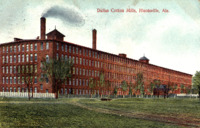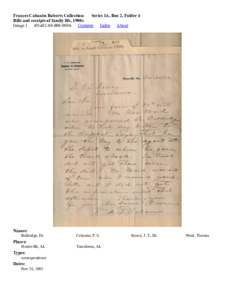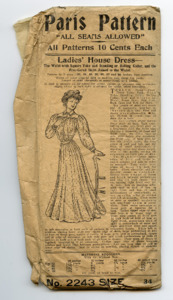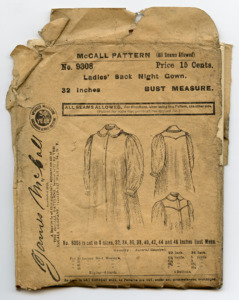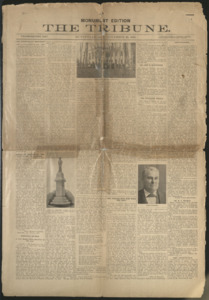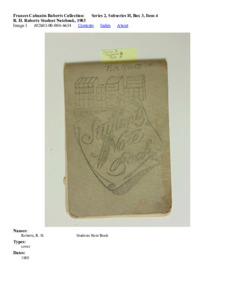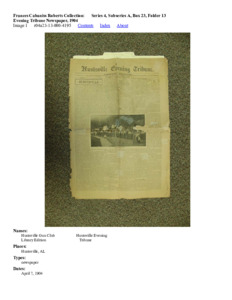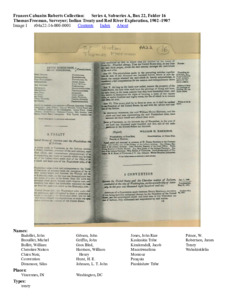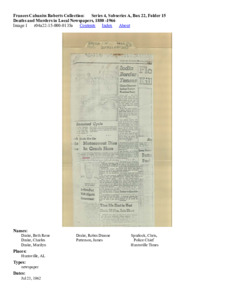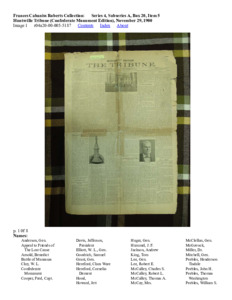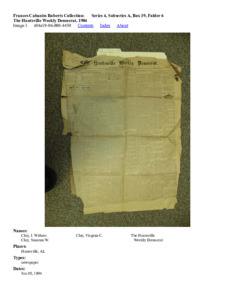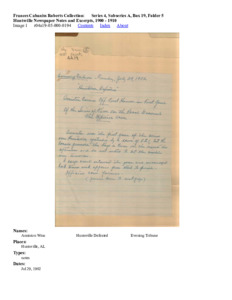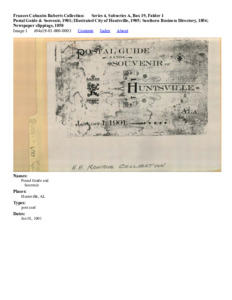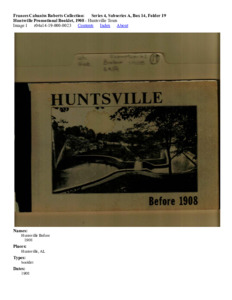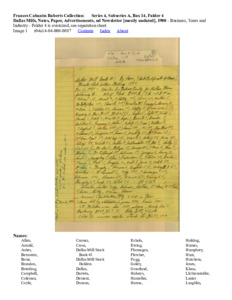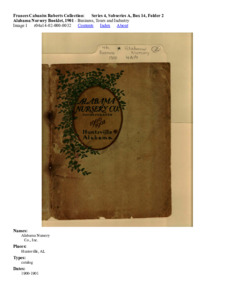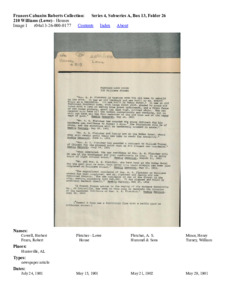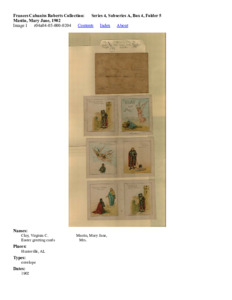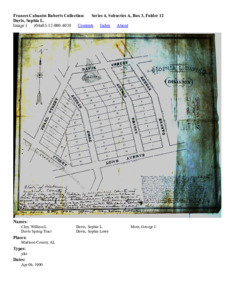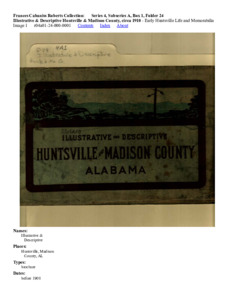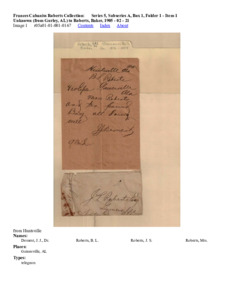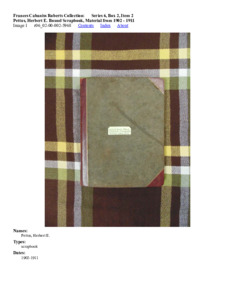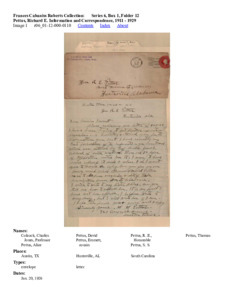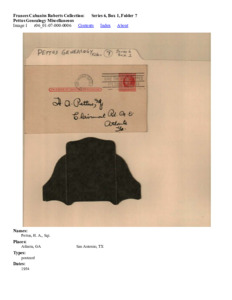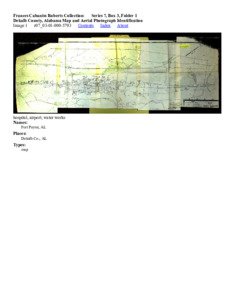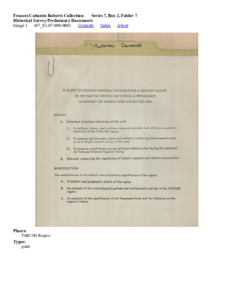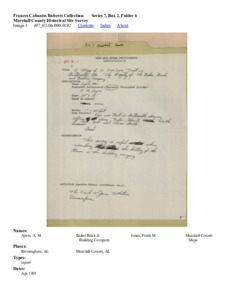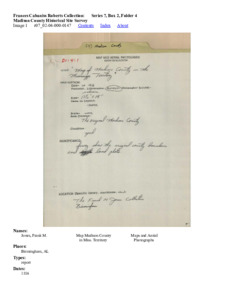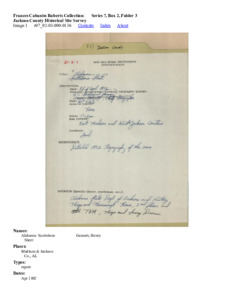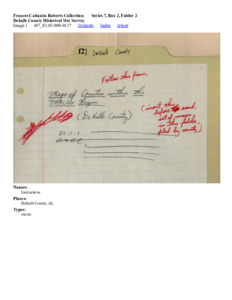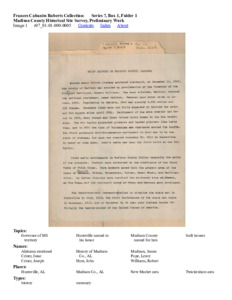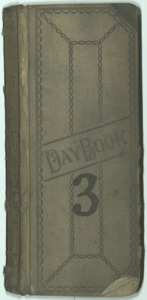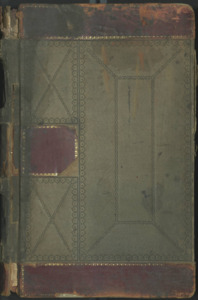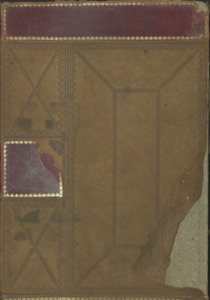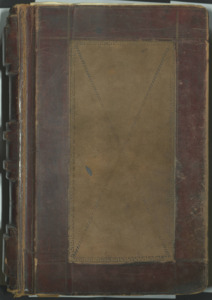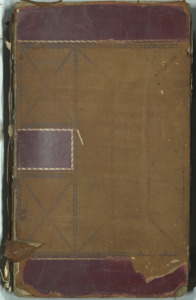
Browse Items (114 total)
-
Dallas Cotton Mills
Front: Dallas Cotton Mills, Huntsville, Ala.
Back: Dallas Cotton Mills, Huntsville, Ala. -
Bills and receipts of family life, 1900s.
A collection of bills, receipts, and other materials related to the Cabaniss household. There are a large amount of receipts for shoes stretching from 1870 to the 1900s. -
Paris Pattern no. 2243, Ladies' House Dress.
Made for a size 34-inch bust, this house dress pattern includes pieces for "The Waist with Square Yoke and Standing or Rolling Collar, and the Five-Gored Skirt Joined to the Waist." The front of the pattern envelope lists all instructions for the construction of the garment as well as material required. The pattern pieces are unprinted. -
McCall Pattern no. 9308, Ladies' Sack Night Gown.
Made for a size 32-inch bust, this nightgown pattern includes five pieces for the front, back, collar, sleeve, and sleeveband. The pattern does not include pieces for the yoke. The front of the pattern envelope lists the material required for each size, and the back describes garment construction. The pattern pieces are unprinted. -
The Tribune, Monument Edition.
Published on Thanksgiving Day 1900, this issue of the Tribune includes stories, songs, and poetry; lists of dead Confederate soldiers from Huntsville and Madison Count; and coverage of the erection of the Confederate monument in downtown Huntsville. Much discussion is made as well of the "Lost Cause," a mythology that perpetuates the belief that the cause of the Confederate States was noble and just and denies that slavery played the central role in secession. Includes columns written by Virginia Clay-Clopton and John Tyler Morgan. -
Huntsville Promotional Booklet, 1908
Huntsville Tours -
Dallas Mills, Notes, Paper, Advertisements, nd Newsletter [mostly undated], 1900
Business, Tours and Industry - Folder 4 is oversized, see separation sheet. -
Alabama Nursery Booklet, 1901
Business, Tours and Industry -
210 Williams (Lowe)
Houses -
Illustrative & Descriptive Huntsville & Madison County, circa 1910
Early Huntsville Life and Memorabilia -
Sallie to Roberts, Ellen, undated
This folder contains correspondence between Sallie L. Roberts and Ellen D. Roberts. -
Unknown (from Gurley, AL) to Roberts, Baker, 1905 - 02 - 21
This folder contains a collection of correspondence from Gurley to Baker L. Roberts. -
Pettus, Herbert E. Bound Scrapbook, Material from 1902 - 1911
This section contains a scrapbook from Herbert E. Pettus which contains posters, correspondence and photographs related to Herbert's time in college. Some items have notes describing what they are or the context surrounding them underneath. -
Pettus, Richard E. Information and Correspondence, 1911 - 1929
This section contains numerous handwritten correspondence letters and envelopes related to Richard E. Pettus including Huntsville Times article snippets recording his death. -
Pettus Genealogy Miscellaneous
Includes photographs of members of the Pettus family (some named, some unnamed) as well as correspondence and newspaper articles related to them as well. -
Steele-Gaines House, modified circa 1903
Madison Co. - Huntsville Site #21, 519 Randolph Ave. SE, Huntsville -
Dekalb County, Alabama Map and Aerial Photograph Identification
This section contains documents and maps related to a historical survey. -
Historical Survey Preliminary Documents
This section appears to be a collection booklet of TARCOG correspondence, job descriptions, employee/management registers and survey forms. Contains maps paired with certain survey reports. -
Marshall County Historical Site Survey
This section contains reports related to the Marshall County Historical Site Survey. The reports are centered around soil-maps and other maps related to traffic. -
Madison County Historical Site Survey
This section contains reports and maps related to the Madison County Historical Site Survey. Maps appear to be hand-drawn. Contains reports and maps from Madison County, Mississippi and Madison County, Alabama. -
Jackson County Historical Site Survey
This section contains reports related to the Jacksonville Historical Site Survey. Relates specifically to photographs taken of different types of maps. Photographs not included. -
Dekalb County Historical Site Survey
This section contains a handful of reports related to photographs (not present), describing their size, significance and additional descriptive details. -
Madison County Historical Site Survey, Preliminary Work
This section contains an essay of historic sites in Madison County, Alabama as well as historic site applications for historic sites in Madison County, Contains descriptions and context for each historic site, why the site should be considered one. Handwritten notes are scribbled across some of the pages, pointing out and correcting typos, making editing suggestions and scratching out lines entirely. -
Harrison Brothers Hardware Company daybook 2, 1898-1902.
This daybook contains the Harrison Brothers' daily store transactions from March 29, 1898, to January 13, 1902. The store was not open on Sundays or holidays. The Harrison Brothers sold exclusively tobacco products such as cigarettes, cigars, chewing tobacco, leaf tobacco, and tobacco-related products until 1900. In March 1900, the Harrison Brothers began selling assorted sets of china dishes and continued to sell primarily Queensware and other home furnishing-related products until 1903 when the store began selling hardware. The store moved from its original location on Jefferson St. to #3 Southside Square in 1897. In December 1901, a fire damaged the front of the Harrison Brothers' number 3 Southside Square storefront as well as other buildings along the street.
Each page in the Harrison Brothers daybooks is divided into columns for the date, transaction details, and debit and credit sales. The year is listed in the upper left-hand corner of each page and the month and day are listed in the columns below on the left side of each transaction. Each transaction includes where the customer was from (for example: "Tuscumbia Ala"), the name of the customer (for example: "W.L. Halsey", "Mrs. Lizzie Barclift", or "Goldsmith + Co."), the items that the customer bought and the rate at which they were sold (for example: "1Bx Spot Cash 25#50" and "1/2Doz #0 Lanterns 5.00"), the total cost of the sale, the customer's method of payment (for example: "By Cash", "By Check", "By Mdse.", "By Work", "By Note" or by credit if no payment method is listed), and the customer account number. If the customer worked in a local cotton mill, the name of the mill is listed next to the customer name such as "Dallas" for Dallas Mills and "West Huntsville" or "W.H." for West Huntsville Manufacturing Company. The customer account numbers reference page numbers in the Harrison Brother's Customer Account Ledgers where customer's store accounts are divided into debit and credit columns. This day book references accounts in Customer Account Ledger 1 located in The University of Alabama in Huntsville Archives and Special Collections. Many accounts do not list customer account numbers if paid for in full with cash or note. These transactions are written over with two ##s or three Cs. Debit and credit columns also appear in the daybooks on the right side of the page. Transactions are added up in the "D" column and payments are recorded in the "C" column. Employee information, invoices, inventory, assets, and liabilities for the Harrison Brothers store are included at the back of the daybook from pages 738-800.
-
Harrison Brothers Hardware Company daybook 3, 1901-1903.
This daybook contains the Harrison Brothers' daily store transactions from January 2, 1902, to December 31, 1903. The store was not open on Sundays or holidays. The Harrison Brothers sold exclusively tobacco products such as cigarettes, cigars, chewing tobacco, leaf tobacco, and tobacco-related products until 1900. In March 1900, the Harrison Brothers began selling assorted sets of china dishes and continued to sell primarily Queensware and other home furnishing-related products until the end of 1903 when the store began selling hardware products such as stoves and pipes. The store moved from its original location on Jefferson St. to #3 Southside Square in 1897. In December 1901, a fire damaged the front of the Harrison Brothers' number 3 Southside Square storefront as well as other buildings along the street. In 1902, the Harrison Brothers hired local contractors and masons, such as Daniel Brandon, to repair the damage and expand the storefront. The Harrison Brothers purchased the number 2 Southside Square storefront the same year and began operating both storefronts in 1904.
Each page in the Harrison Brothers daybooks is divided into columns for the date, transaction details, and debit and credit sales. The year is listed in the upper left-hand corner of each page and the month and day are listed in the column below on the left side of each transaction. Each transaction includes where the customer was from (for example: "Tuscumbia Ala"), the name of the customer (for example: "W.L. Halsey", "Mrs. Lizzie Barclift", or "Goldsmith + Co."), the items that the customer bought and the rate at which they were sold (for example: "1Bx Spot Cash 25#50" and "1/2Doz #0 Lanterns 5.00"), the total cost of the sale, the customer's method of payment (for example: "By Cash", "By Check", "By Mdse.", "By Work", "By Note" or by credit if no payment method is listed), and the customer account number. If the customer worked in a local cotton mill, the name of the mill is listed next to the customer name such as "Dallas" for Dallas Mills, and "West Huntsville" or "W.H." for West Huntsville Manufacturing Company. The customer account numbers reference page numbers in the Harrison Brother's Customer Account Ledgers where customer's store accounts are divided into debit and credit columns. The Customer Account Ledgers referenced by this daybook are located in The University of Alabama in Huntsville Archives and Special Collections. Many accounts do not list customer account numbers if paid for in full with cash or note. These transactions are written over with two ##s or three Cs. Debit and credit columns also appear in the daybooks on the right side of the page. Transactions are added up in the "D" column and payments are recorded in the "C" column. Employee information, invoices, inventory, assets, and liabilities for the Harrison Brothers store are included at the back of the daybook from pages 463-500. Information about the contractors that restored Harrison Brothers in 1902 can be found on pages 484 and 500.
-
Harrison Brothers Hardware Company daybook 4, 1904-1905.
This daybook contains the Harrison Brothers' daily store transactions from January 1, 1904, to December 31, 1905. The store was not open on Sundays or holidays. During these years the Harrison Brothers were no longer selling tobacco products. After renovating the number 3 Southside Square storefront and purchasing the number 2 storefront in 1902, the Harrison Brothers continued to sell china products such as dish assortments, glass products such as lamps, enameled steelware such as pots and pans, cutlery, and some hardware products such as stoves and pipes in 1904. At the end of 1904, the Harrison Brothers began to sell furniture such as rockers, chairs, beds, and window shades in the number 3 storefront and continued to sell Queensware in number 2. The store's furniture inventory expanded in 1905 to include mirrors, cradles, baby buggies, stove ranges, and cooking appliances such as waffle irons.
Each page in the Harrison Brothers daybooks is divided into columns for the date, transaction details, and debit and credit sales. The year is listed in the upper left-hand corner of each page and the month and day are listed in the column below on the left side of each transaction. Each transaction includes the name of the customer (for example: "W.L. Halsey", "Mrs. Lizzie Barclift", or "Goldsmith + Co."), the items that the customer bought, the total cost of the sale, the customer's method of payment (for example: "By Cash", "By Check", "By Mdse.", "By Work", "By Note" or by credit if no payment method is listed), and the customer account number. Some transactions include where the customer was from (for example: "Tuscumbia Ala") or, if the customer worked in a local cotton mill, the name of the mill is listed next to the customer name such as "Merrimac" or "M" for Merrimack Manufacturing Co., "Dallas" or "D" for Dallas Mills, and "Lowe Mill" or "LM" for Lowe Mill. The customer account numbers correlate to a page number in the Harrison Brother's Customer Account Ledgers where customer's store accounts are divided into debit and credit columns. This day book references accounts in Customer Account Ledger 1 located in The University of Alabama in Huntsville Archives and Special Collections and another ledger located in the Huntsville-Madison County Public Library Special Collections. Many accounts do not list customer account numbers if paid for in full with cash or note. These transactions are written over with two ##s. Debit and credit columns also appear in the daybooks on the right side of the page. Transactions are added up in the "D" column and payments are recorded in the "C" column. Employee information, invoices, inventory, assets, and liabilities for the Harrison Brothers store are included at the back of the daybook from pages 460-500.
-
Harrison Brothers Hardware Company customer account ledger 1, 1897-1904.
This Customer Account Ledger contains the credit account information for Harrison Brothers customer transactions from 1898-1904. The index at the front of the ledger is organized alphabetically by the customer's last name. Each index page is dived into two columns. The left column lists the name of the customer and the right column lists the customer's city of residence and the page number of the customer's account. The page numbers reference pages in the ledger where one or multiple accounts are listed. Each customer account page is divided into a debit "D" and credit "C" column separated by a blue line. The customer's name and city of residence are written at the top of each account. In the debit column, the year is written at the top left and months and days of transactions are listed below in the first two columns. The next two columns reference a customer's transactions in a particular daybook listed as "B B #" and the page number that the transaction is listed on. This ledger references transactions in daybooks 1, 2, and 3 located in the University of Alabama in Huntsville Archives and Special Collections. In the credit column, the month and day of a customer's payments are listed in the first two columns. The next two columns list the daybook and the page number that the customer's payment is recorded on. The payment amount is listed in the rightmost column of the page. The debit and credit columns are either balanced at the bottom of the page or the Harrison Brothers indicated that the customer account was carried to a new page in the ledger.
-
Harrison Brothers Hardware Company customer account ledger 2, 1889-1896.
This Customer Account Ledger contains the credit account information for Harrison Brothers customer transactions from 1889-1896. The index at the front of the ledger is organized alphabetically by the customer's last name. Each index page is dived into two columns. The left column lists the name of the customer and the right column lists the customer's city of residence and the page number of the customer's account. The page numbers reference pages in the ledger where one or multiple accounts are listed. Each customer account page is divided into a debit "D" and credit "C" column separated by a blue line. The customer's name and city of residence are written at the top of each account. In the debit column, the year is written at the top left and months and days of transactions are listed below in the first two columns. The next column references a customer's transactions in a particular daybook listed as "B B #" and the page number in the referenced book is listed in the following column. This ledger references transactions in daybooks 1 and 2. These daybooks, not included in the collection of account books at the University of Alabama in Huntsville Archives and Special Collections, likely recorded tobacco sales from the Harrison Brothers store on Jefferson Street prior to their move to Southside Square in 1897. In the credit column, the month and day of a customer's payments are listed in the first two columns. The next two columns list the daybook and the page number that the customer's payment is recorded on. The payment amount is listed in the rightmost column of the page. The debit and credit columns are either balanced at the bottom of the page or the Harrison Brothers indicated that the customer account was carried to a new page in the ledger. Many pages in this ledger are empty and customer accounts begin on page 214.
-
Harrison Brothers Hardware Company customer account ledger 5, 1907-1917.
This Customer Account Ledger contains the credit account information for Harrison Brothers customer transactions from 1907 to 1914. The index at the front of the ledger is organized alphabetically by the customer's last name. Each index page is dived into two columns each listing the customer's name on the left side and the page number of the customer's account on the right. The page numbers reference pages in the ledger where one or multiple accounts are listed. Each customer account page is divided into a debit "D" and credit "C" column separated by a blue line. In the debit column, the year is listed in the left-hand corner of each account with months and days listed in the first two columns. The next column references a customer's transactions in a particular daybook listed as "Note B #" and the page number in the referenced book is listed in the following column. This ledger references transactions in daybooks 6, 7, 8, and 9 located in the University of Alabama in Huntsville Archives and Special Collections. In the credit column, the month and day of a customer's payments are listed in the first two columns. The next column lists each of the dates that a payment was made, the method of payment, and the amount paid (for example: "Cash 1.00 6/3 2.00 7/5"). Many dates and payments are often listed on a single line and added up in the rightmost column on the page. The debit and credit columns are balanced at the bottom of the page or the Harrison Brothers indicated that the customer account was carried to a new page in the ledger. A customer's city of residence is sometimes listed next to the name at the top of a customer account and, if the customer worked in a local cotton mill such as Merrimack, Lowe Mill, West Huntsville, or Bell Factory; the name of the mill is listed in the ledger as "Merrimac", "L.M.", "Dallas", "W.H.", or "Bell Factory Ala".
-
Dallas Manufacturing Company minute book, 1890-1907.
This minute book documents the activities of the Board of Directors of the Dallas Manufacturing Company in Huntsville, Alabama. The book includes meeting minutes, company correspondence, list of contracts with suppliers, information about company stock and production, lists of subscribers, and statements of profits and operating expenses.
Notably, the minute book also includes a February 1893 letter from Oscar Goldsmith noting that "The Huntsville Land Company have built 50 double Houses for the Employees of Dallas M'f'g. Company. And as per request of Mr. Dallas will build 25 more houses for the same purpose." Goldsmith's letter is accompanied by a plat map that indicates the location of the houses. Streets shown include Pettigrew Avenue, Mellette Avenue, Halsey Avenue, Rison Avenue, Stevens Avenue, Humes Avenue, O'Shaughnessy Avenue, McCullough Avenue, Dallas Avenue, and cross streets.
